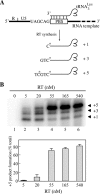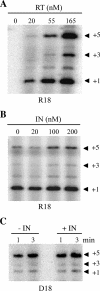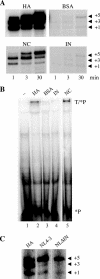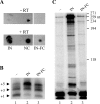Molecular mechanisms by which human immunodeficiency virus type 1 integrase stimulates the early steps of reverse transcription
- PMID: 17626089
- PMCID: PMC2045400
- DOI: 10.1128/JVI.00519-07
Molecular mechanisms by which human immunodeficiency virus type 1 integrase stimulates the early steps of reverse transcription
Abstract
Reverse transcriptase (RT) and integrase (IN) are two essential enzymes that play a critical role in synthesis and integration of the retroviral cDNA, respectively. For human immunodeficiency virus type 1 (HIV-1), RT and IN physically interact and certain mutations and deletions of IN result in viruses defective in early steps of reverse transcription. However, the mechanism by which IN affects reverse transcription is not understood. We used a cell-free reverse transcription assay with different primers and compositions of deoxynucleoside triphosphates to differentially monitor the effect of IN on the initiation and elongation modes of reverse transcription. During the initiation mode, addition of IN stimulated RT-catalyzed reverse transcription by fourfold. The stimulation was specific to IN and could not be detected when the full-length IN was replaced with truncated IN derivatives. The IN-stimulated initiation was also restricted to the template-primer complex formed using tRNA(3)(Lys) or short RNA oligonucleotides as the primer and not those formed using DNA oligonucleotides as the primer. Addition of IN also produced a threefold stimulation during the elongation mode, which was not primer dependent. The stimulation of both initiation and elongation by IN was retained in the presence of an RT trap. Furthermore, IN had no effect on steps at or before template-primer annealing, including packaging of viral genomic RNA and tRNA(3)(Lys). Taken together, our results showed that IN acts at early steps of reverse transcription by increasing the processivity of RT and suppressing the formation of the pause products.
Figures







Similar articles
-
Interaction between Reverse Transcriptase and Integrase Is Required for Reverse Transcription during HIV-1 Replication.J Virol. 2015 Dec;89(23):12058-69. doi: 10.1128/JVI.01471-15. Epub 2015 Sep 23. J Virol. 2015. PMID: 26401032 Free PMC article.
-
MD simulations of HIV-1 RT primer-template complex: effect of modified nucleosides and antisense PNA oligomer.J Biomol Struct Dyn. 2013;31(6):539-60. doi: 10.1080/07391102.2012.706076. Epub 2012 Aug 13. J Biomol Struct Dyn. 2013. PMID: 22888964
-
The G490E mutation in reverse transcriptase does not impact tRNA primer selection by HIV-1 with altered PBS and A-loop.Virology. 2006 Sep 1;352(2):380-9. doi: 10.1016/j.virol.2006.04.019. Epub 2006 Jun 15. Virology. 2006. PMID: 16781756
-
HIV-1 reverse transcription initiation: a potential target for novel antivirals?Virus Res. 2008 Jun;134(1-2):4-18. doi: 10.1016/j.virusres.2007.12.009. Epub 2008 Feb 6. Virus Res. 2008. PMID: 18255184 Review.
-
Interactions between human immunodeficiency virus type 1 reverse transcriptase, tRNA primer, and nucleocapsid protein during reverse transcription.J Hum Virol. 2000 Jan-Feb;3(1):16-26. J Hum Virol. 2000. PMID: 10774803 Review.
Cited by
-
Cis-Allosteric Regulation of HIV-1 Reverse Transcriptase by Integrase.Viruses. 2022 Dec 21;15(1):31. doi: 10.3390/v15010031. Viruses. 2022. PMID: 36680070 Free PMC article.
-
Shifting Retroviral Vector Integrations Away from Transcriptional Start Sites via DNA-Binding Protein Domain Insertion into Integrase.Mol Ther Methods Clin Dev. 2018 Nov 13;12:58-70. doi: 10.1016/j.omtm.2018.11.001. eCollection 2019 Mar 15. Mol Ther Methods Clin Dev. 2018. PMID: 30534579 Free PMC article.
-
Augmentation of reverse transcription by integrase through an interaction with host factor, SIP1/Gemin2 Is critical for HIV-1 infection.PLoS One. 2009 Nov 13;4(11):e7825. doi: 10.1371/journal.pone.0007825. PLoS One. 2009. PMID: 19915660 Free PMC article.
-
Structure and function of retroviral integrase.Nat Rev Microbiol. 2022 Jan;20(1):20-34. doi: 10.1038/s41579-021-00586-9. Epub 2021 Jul 9. Nat Rev Microbiol. 2022. PMID: 34244677 Free PMC article. Review.
-
Correlation of recombinant integrase activity and functional preintegration complex formation during acute infection by replication-defective integrase mutant human immunodeficiency virus.J Virol. 2012 Apr;86(7):3861-79. doi: 10.1128/JVI.06386-11. Epub 2012 Jan 25. J Virol. 2012. PMID: 22278243 Free PMC article.
References
-
- Arts, E. J., M. Ghosh, P. S. Jacques, B. Ehresmann, and S. F. Le Grice. 1996. Restoration of tRNA3Lys-primed(-)-strand DNA synthesis to an HIV-1 reverse transcriptase mutant with extended tRNAs. Implications for retroviral replication. J. Biol. Chem. 271:9054-9061. - PubMed
-
- Arts, E. J., X. Li, Z. Gu, L. Kleiman, M. A. Parniak, and M. A. Wainberg. 1994. Comparison of deoxyoligonucleotide and tRNA(Lys-3) as primers in an endogenous human immunodeficiency virus-1 in vitro reverse transcription/template-switching reaction. J. Biol. Chem. 269:14672-14680. - PubMed
-
- Brown, P. O. 1997. Integration. Cold Spring Harbor Laboratory Press, Cold Spring Harbor, NY. - PubMed
Publication types
MeSH terms
Substances
Grants and funding
LinkOut - more resources
Full Text Sources
Other Literature Sources

